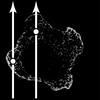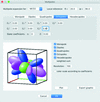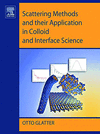issue contents
February 2019 issue

Cover illustration: Mapping of individual dislocations with dark-field X-ray microscopy. A dark-field image of a large single-crystal diamond, acquired with a diffraction microscope. Three dislocations are present, all exhibiting kinks, as well as several scratches on the surface. Courtesy of Jakobsen et al. [J. Appl. Cryst. (2019), 52, 122-132].
research papers
A description is presented of the instrument design and performance of BILBY, the new time-of-flight small-angle neutron scattering instrument located at the Australian Nuclear Science and Technology Organisation.
The direct-derivation method has been applied to the quantitative phase analysis of mixtures containing amorphous components. A theoretical basis has been given to the formula for deriving individual weight fractions from observed intensity data. The formula has been experimentally tested by whole-powder-pattern fitting to the observed patterns of mixtures containing amorphous components.
Download citation


Download citation


The unambiguous determination of the crystal structure of two NH4TiOF3 polymorphs is provided. NH4TiOF3 is subject to a second-order phase transition from Pca21 to Pma2 on heating at around ∼453 K.
Carved-ellipsoid models are built and their scattering functions are explored. These models are applied successfully to the scattering curves of newly developed nano-scaled molecular clusters.
Download citation


Download citation


A structural phase transition from a cubic to a monoclinic structure and subsequently to a hexagonal structure is observed with increasing cation size in the rare earth sesquioxide (Eu1−xLax)2O3. The microstrain and substitutional disorder in the crystal structure are considered to be the causes of the observed phase transition.
This article describes a novel but simple and rapid transmission X-ray diffraction method for determining precise unit-cell parameters from thick samples whose mass is irregularly distributed along the beam direction. The approach is demonstrated on two phantoms containing hydroxyapatite and on a human second metacarpal bone which contains carbonated hydroxyapatite.
Open  access
access
 access
accessA framework for the optimization of neutron reflectometry experiments based on Bayesian statistics and information theory is presented.
Atomic level structural changes of pyrolized beech and apricot plant material were modeled using two different approaches: total wide-angle X-ray scattering curve fitting and pair distribution function analysis. It is shown that the information obtained from the combination of these two analytical techniques is complementary, while using only one can provide a partial and incomplete view of structural changes.
An energy-dispersive Laue diffraction technique based on a conventional sealed X-ray tube in combination with a PILATUS detector applicable for precise determination of lattice constants in large-scale bulky non-movable samples is developed and described, and its performance is tested.
New data evaluation strategies are presented for depth-resolved X-ray residual stress analysis performed in the energy-dispersive diffraction mode.
Small-angle X-ray scattering is used to characterize the structure of a block copolymer patterned in a contact-hole template.
An α-quartz crystal intended to condition the beam in a multi-crystal X-ray optical arrangement was designed and commissioned for use in rocking-curve topography of quartz samples at beamline 1-BM of the Advanced Photon Source. Test results for a flat sample and for a spherically bent sample are presented.
An X-ray microscopy approach for mapping deeply embedded dislocations with a resolution of currently 200 nm is presented. The technique involves scanning an aperture in the back focal plane, which allows the strain fields around dislocations to be visualised with a strain resolution better than 10−4.
A methodological approach is presented for computing the structural formula of clay minerals from transmission electron microscopy–energy-dispersive X-ray spectroscopy (TEM-EDX) data of individual particles, including pure and complex interstratifications. The combination of TEM-EDX and modelling of XRD patterns enables the refinement of the TEM-EDX-based structural formula. This methodology allows identification of the mineral composition and mineral transformations happening in both geological and industrial processes.
This work reports a high-throughput screening of Li and Na compounds. Bond-valence theory, graph percolation and geometric analysis are combined to investigate the structural properties of fast ion conductors. The results suggest that the abundance of fast ion conductors would be substantially lower in the Na case.
A sensitive method of measuring the β31 coefficient of the quadratic electrogyration effect in potassium dihydrogen phosphate (KDP)-type crystals is proposed. The uncertainties of the method due to inaccuracies in crystal cutting and alignment are analyzed in detail. The experimental data presented relate to KDP crystals at room and higher temperatures.
short communications
The crystal quality of ZnMgO nanowalls grown on 4H-SiC substrates has been investigated by X-ray diffraction.
Optimization of protein crystals using the vapour-diffusion sitting-drop method is time consuming, labour intensive and costly. This article presents the concept, design and evaluation of a novel low-cost and high-capacity sitting-drop bridge. It is hoped that this will help to remove the present bottleneck in crystal optimization and streamline the overall process to obtain high-quality crystals.
computer programs
Mag2Pol is a graphical user interface program which is devoted to the treatment of data from polarized neutron diffractometers with spherical polarization analysis. A magnetic structure model including magnetic domain populations can be refined in a least-squares fit and can also be correlated with an integrated intensity data set in a joint refinement.
A software package for thin-film analysis implemented on the combined basis of two-wavelength X-ray reflectometry, refractometry and diffuse X-ray scattering is proposed.
Open  access
access
 access
accessThe refnx Python modules for neutron and X-ray reflectometry data analysis are introduced. A sample analysis illustrates a Bayesian approach using a Markov-chain Monte Carlo algorithm to understand the confidence in the fit parameters.
REFLEX is a user-friendly program dedicated to the analysis of specular X-ray (soft and hard) and neutron reflectivity measurements.
A package for Mathematica has been developed, containing the most important point- and space-group information together with tables for various photon–atom interactions. It includes basic functions for handling crystallographic data as well as procedures for calculating various quantities in relation to crystallography and X-ray diffraction.
D+ is a computer program that calculates both monochromatic and anomalous X-ray scattering curves from solutions of complex structures, using a hierarchical reciprocal grid algorithm.
book reviews
Free 

Free 



 journal menu
journal menu














































